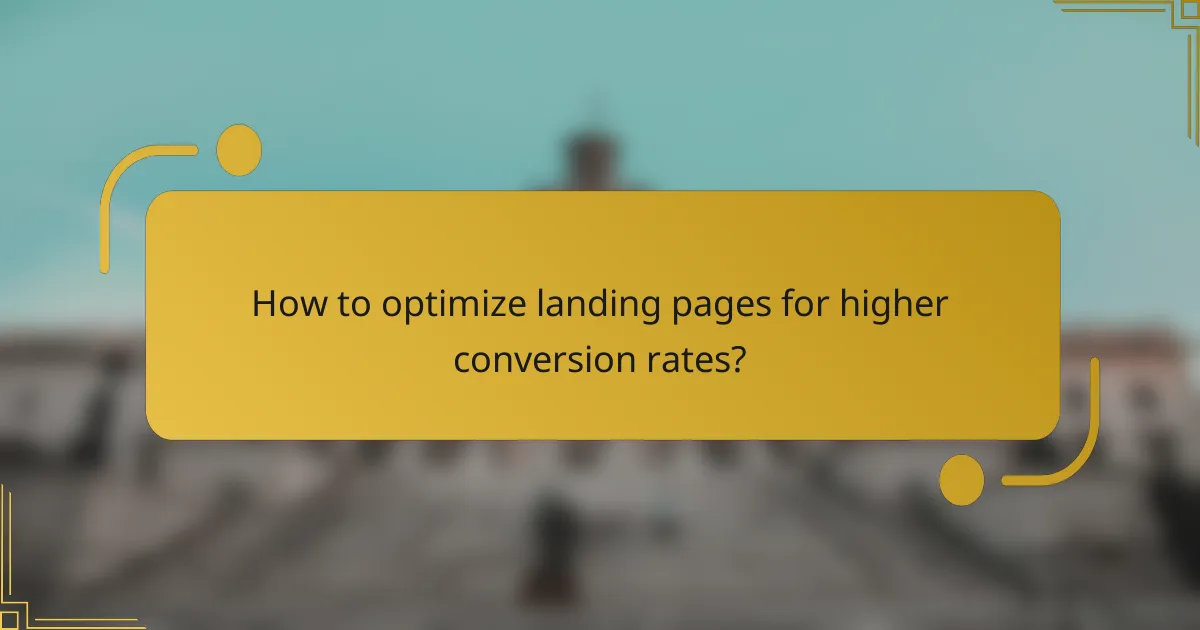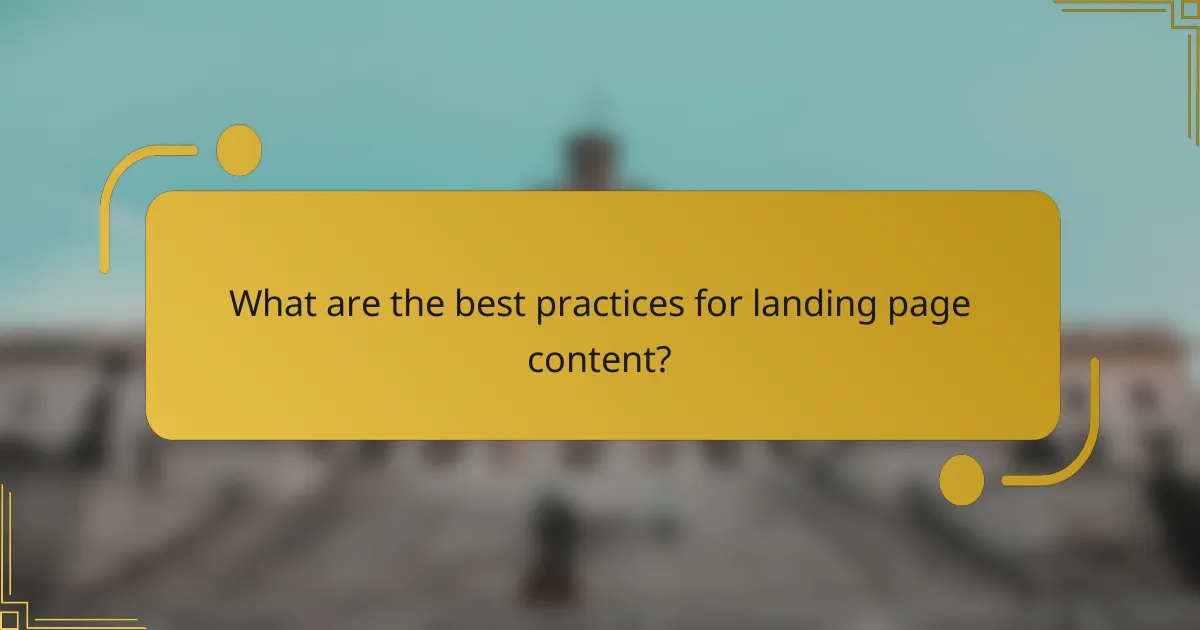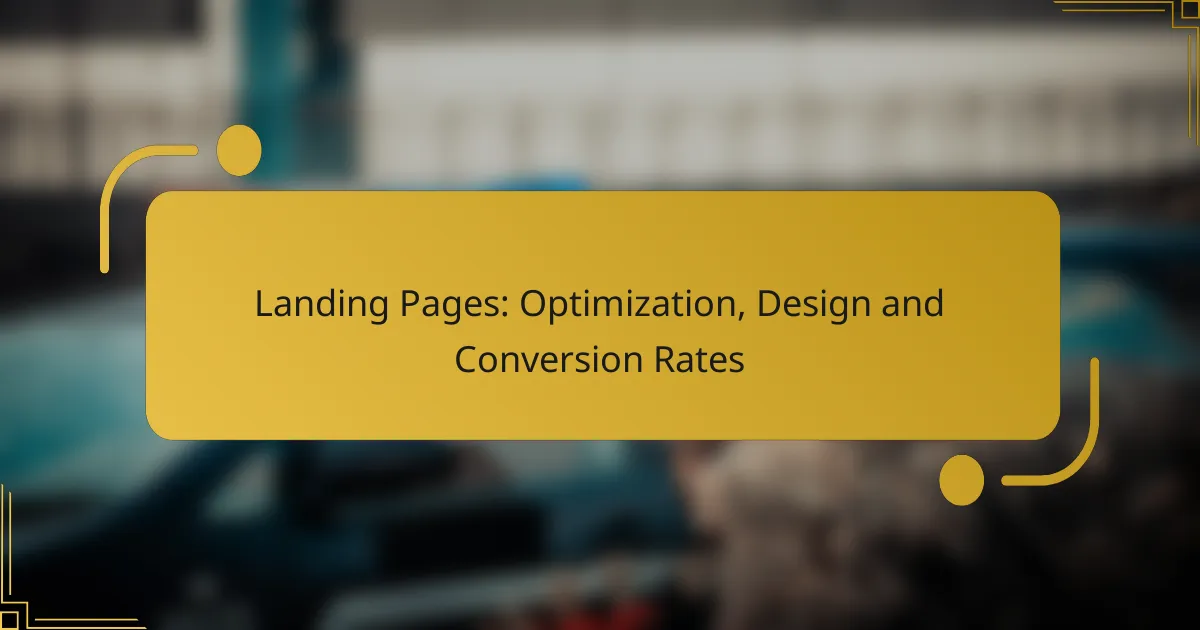Optimizing landing pages is essential for increasing conversion rates, as it involves enhancing user experience and directing visitors toward specific actions. By implementing strategies such as clear calls-to-action, A/B testing, and responsive design, businesses can create effective landing pages that not only attract visitors but also encourage them to engage and convert.

How to optimize landing pages for higher conversion rates?
To optimize landing pages for higher conversion rates, focus on enhancing user experience and guiding visitors towards desired actions. Key strategies include clear calls-to-action, A/B testing, fast loading speeds, responsive design, and incorporating social proof.
Use clear calls-to-action
Clear calls-to-action (CTAs) are essential for directing users on what to do next. Use action-oriented language and ensure the CTAs stand out visually, such as through contrasting colors or larger buttons. Examples include phrases like “Get Started,” “Sign Up Now,” or “Download Free Guide.”
Position CTAs prominently on the page, ideally above the fold and at the end of content sections. Avoid cluttering the page with multiple CTAs that could confuse visitors; instead, focus on one primary action to drive conversions.
Implement A/B testing
A/B testing involves comparing two versions of a landing page to determine which performs better in terms of conversions. Test different elements such as headlines, images, and CTA placements to see what resonates most with your audience. Small changes can lead to significant improvements.
Use tools like Google Optimize or Optimizely to facilitate testing. Aim for a sample size that provides statistically significant results, typically in the hundreds or thousands, depending on your traffic levels.
Enhance page load speed
Page load speed significantly impacts user experience and conversion rates. Aim for a load time of under three seconds, as longer delays can lead to higher bounce rates. Use tools like Google PageSpeed Insights to analyze and improve your page speed.
Optimize images, leverage browser caching, and minimize HTTP requests to enhance loading times. Regularly monitor performance, especially after making updates or changes to the page.
Utilize responsive design
Responsive design ensures that your landing page displays well on various devices, including desktops, tablets, and smartphones. With a growing number of users accessing websites via mobile, a responsive layout is crucial for maintaining engagement and driving conversions.
Test your landing page on multiple devices and screen sizes to ensure a seamless experience. Use flexible grids and layouts, and ensure that buttons and links are easily clickable on smaller screens.
Incorporate social proof
Social proof, such as testimonials, reviews, and user-generated content, can enhance credibility and encourage conversions. Displaying positive feedback prominently on your landing page can reassure potential customers about their decision to engage with your brand.
Consider using star ratings, customer photos, or case studies to illustrate the value of your product or service. Highlighting the number of satisfied customers or showcasing well-known clients can further boost trust and conversion rates.

What design elements improve landing page effectiveness?
Key design elements that enhance landing page effectiveness include effective use of whitespace, consistent branding elements, high-quality visuals, and readable typography. These components work together to create a user-friendly experience that can significantly boost conversion rates.
Effective use of whitespace
Whitespace, or negative space, is the area around design elements that helps to create a clean and organized layout. By strategically using whitespace, you can guide users’ attention to important content and calls to action, making it easier for them to navigate the page. Aim for a balanced layout with ample spacing between text, images, and buttons.
Too little whitespace can lead to a cluttered appearance, which may overwhelm visitors. A good rule of thumb is to ensure that key elements have at least 20-30 pixels of space around them to enhance visibility and focus.
Consistent branding elements
Consistency in branding elements, such as colors, fonts, and logos, reinforces brand identity and builds trust with visitors. Use a cohesive color palette that aligns with your brand’s personality and ensures that all elements on the landing page reflect this style. This creates a seamless experience that strengthens recognition.
Incorporate your logo prominently and maintain uniformity in font choices across headings and body text. This not only enhances aesthetics but also helps users associate the landing page with your brand, increasing the likelihood of conversion.
High-quality visuals
High-quality visuals, including images and videos, can significantly impact user engagement on landing pages. Use professional images that are relevant to your content and resonate with your target audience. Avoid stock photos that feel generic, as they can detract from authenticity.
Consider using videos to explain complex concepts or showcase products, as they can increase time spent on the page. Aim for visuals that load quickly and are optimized for various devices to ensure a smooth user experience.
Readable typography
Readable typography is crucial for ensuring that visitors can easily consume your content. Choose fonts that are legible across different devices and screen sizes, typically sans-serif fonts for digital use. Maintain a font size of at least 16 pixels for body text to enhance readability.
Use contrasting colors for text and background to improve visibility. Limit the number of different fonts to two or three to maintain a clean look, and ensure that headings are distinct from body text to create a clear hierarchy.

What are the best practices for landing page content?
Effective landing page content is crucial for maximizing conversions. Best practices focus on clearly communicating user benefits, crafting engaging headlines, and leveraging social proof through testimonials and case studies.
Focus on user benefits
Highlighting user benefits is essential for capturing attention and driving action. Clearly articulate how your product or service solves a problem or improves the user’s situation. Use direct language that resonates with your target audience.
Consider creating a bulleted list of key benefits to enhance readability. For example, if you offer a financial planning tool, benefits might include “save time,” “reduce stress,” and “achieve financial goals.” This format allows users to quickly grasp the value proposition.
Use concise and engaging headlines
Your headlines should grab attention and convey the main message succinctly. Aim for headlines that are no longer than 10-12 words, using strong action verbs and clear language. A compelling headline can significantly increase the likelihood of users staying on the page.
Test different headline variations to see which resonates best with your audience. Tools like A/B testing can help determine which phrases lead to higher engagement and conversion rates.
Include testimonials and case studies
Incorporating testimonials and case studies builds trust and credibility. Potential customers are more likely to convert if they see evidence of others benefiting from your offering. Use real quotes from satisfied customers, along with their names and photos if possible.
Case studies should detail specific challenges faced by previous clients and how your product or service provided a solution. This narrative approach not only showcases results but also helps potential customers envision their own success.

What metrics should be tracked for landing page performance?
To effectively evaluate landing page performance, focus on key metrics such as conversion rate, bounce rate, average time on page, and click-through rate. These metrics provide insights into user engagement and the overall effectiveness of your landing page in achieving its goals.
Conversion rate
The conversion rate measures the percentage of visitors who complete a desired action, such as making a purchase or signing up for a newsletter. A higher conversion rate indicates that your landing page effectively persuades visitors to take action.
To improve conversion rates, consider A/B testing different elements like headlines, calls to action, and images. Aim for a conversion rate in the range of 2-5% for most industries, but this can vary significantly based on the niche and target audience.
Bounce rate
Bounce rate refers to the percentage of visitors who leave your landing page without interacting further. A high bounce rate may indicate that your content is not engaging or relevant to the audience.
To reduce bounce rates, ensure that your landing page aligns with the expectations set by your marketing campaigns. A bounce rate below 40% is generally considered good, while rates above 70% may signal a need for improvement.
Average time on page
Average time on page measures how long visitors stay on your landing page before navigating away. Longer durations typically suggest that users find the content valuable and engaging.
To increase average time on page, provide high-quality content, use engaging visuals, and ensure easy navigation. Aim for an average time of at least 30 seconds, but this can vary based on the complexity of the content.
Click-through rate
Click-through rate (CTR) indicates the percentage of users who click on a specific link or call to action on your landing page. A higher CTR suggests that your calls to action are compelling and effectively encourage user interaction.
To enhance CTR, use clear and persuasive language in your calls to action, and position them prominently on the page. A typical CTR for landing pages ranges from 2-10%, depending on the industry and the effectiveness of the messaging.

How to choose the right landing page builder?
Choosing the right landing page builder involves evaluating your specific needs, technical skills, and budget. Look for features that align with your goals, such as customization options, templates, and integration capabilities.
Key features to consider
When selecting a landing page builder, focus on essential features like drag-and-drop functionality, mobile responsiveness, and A/B testing capabilities. These elements enhance usability and improve conversion rates. Additionally, consider integration with email marketing tools and CRM systems to streamline your workflow.
Pricing and budget
Landing page builders typically offer various pricing tiers, ranging from free plans with basic features to premium options that provide advanced functionalities. Assess your budget and determine which features are necessary for your campaigns. Many builders charge monthly fees, while some offer annual discounts, which can save you money in the long run.
User experience and support
A good landing page builder should provide an intuitive user experience, making it easy to create and publish pages without extensive technical knowledge. Look for platforms that offer customer support, tutorials, and a community forum to assist you in troubleshooting and optimizing your landing pages.
Customization and templates
Customization options are crucial for creating unique landing pages that reflect your brand. Choose a builder that offers a variety of templates tailored to different industries and goals. This can save you time while ensuring your pages are visually appealing and effective in converting visitors.



